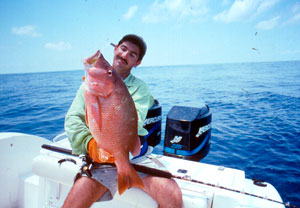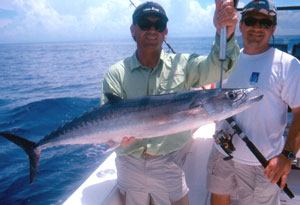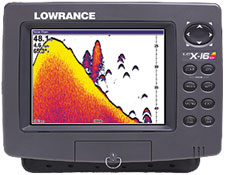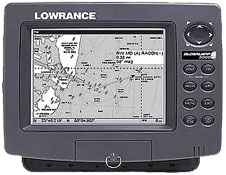Technology has changed the face of fishing. Thanks to modern electronics, the average fisherman now has the ability to pinpoint tiny hot spots that were once the privileged property of seasoned skippers. Those infamous black books brimming with secret loran or GPS coordinates are becoming less precious each year as many of these formerly covert spots find their way onto electronic maps and charts. These days, any angler with a chart plotter or home computer can simply boot up a chart, take a bearing to a wreck, ledge or hump and head for it! How much easier can you get?
Unless you're an experienced captain with a solid working knowledge of your electronics, however, the numerous features offered by many of today's units may be a bit overwhelming. Because of this you may not be realizing the full potential of your electronics, relying instead on their basic functions. Outlined below are several examples of how to use electronics to your advantage. By applying some of these tactics to your fishing, you too will become a more proficient angler.

Fishfinders
A fishfinder is your eye to what lies beneath the surface. Unfortunately, few anglers use their fishfinders until they arrive at their destinations, and that could be a costly mistake. Providing you have a quality unit and transducer that have been properly installed, the entire water column and bottom should be studied en route to and from the fishing grounds. By doing so you might just uncover a concentration of bait or game fish before you reach your primary destination. When fish are concentrating at a particular depth, experienced fishermen usually position a bait at the same level as the activity, especially if they're not getting any strikes near the surface.

A quality fishfinder will also reveal the position of the thermocline. The thermocline is the boundary that separates two layers of the water column with different temperatures, and usually appears on the fishfinder as a faint horizontal line. Many tuna and shark fishermen place at least one bait near the thermocline.
The ability to clearly distinguish specific bottom types (e.g., mud vs. sand) and the fish themselves can be crucial to success, and often justifies the expense of a high-quality fishfinder. With experience and some fine-tuning you can often determine bottom composition, as well as the species of individual fish on your sounder. This is where power and high resolution come into play.

The Lowrance X-16 CI is a prime example of just how amazing some of these modern fishfinders are. With a dual-frequency transducer, this color LCD unit is among the most powerful fishfinders ever developed for recreational angling. The unit offers up to 1,000 watts of RMS power in the 50 kHz mode, and 500 watts of RMS power in the 200 kHz mode (a 200 kHz transom-mount Skimmer transducer is also available). With 15,170 pixels per square inch, the new X-16 CI LCD color unit -- complete with a 6.38-inch color display that can be viewed in direct sunlight ---yields sharp resolution to depths beyond 3,000 feet. Available with a programmable color palette, target separation and both bottom and fish identification can be greatly enhanced, resulting in extremely accurate readings.
 |
 |
Among the unit's other impressive features is its Digital Recording/Playback capability, which lets the user save the GPS coordinates of a spot, as well as its sonar image. In the past, the location of a hot spot was recorded by hitting the "save" or "man overboard" button. The fisherman would then note the coordinates and other information in the unit's memory or a logbook for future reference. However, with the new X-16 CI you can save, record and play back sonar images and their respective GPS coordinates. These recordings can even be downloaded to a personal computer for viewing and archiving.
Transducer Logic
As a very general rule, the best readings over a broad area of bottom in depths of less than 300 feet are achieved with a high-frequency transducer (200kHz) with a wide cone angle (20 degrees). For readings greater than 300 feet, a Iow-frequency (50 kHz) transducer with a narrower cone angle (eight degrees) is best. Fishermen who use their boats in a variety of inshore and offshore waters should opt for a dual-frequency transducer to maintain optimum performance.
GPS and Track Plotters
GPS now offers repeatable accuracy of within five feet. Therefore, if a fisherman wants to return to a favorite wreck, ledge or other hot spot, he'll come incredibly close to scoring a direct hit. Quality GPS units have a Man Overboard (MOB) or Save feature that instantly stores the vessel's current coordinates. It's an obvious safety feature that's equally valuable for keeping track of fish. Should you hook a large fish, for example, a simple push of the MOB or Save button will mark the place where strike occurred. This allows you to return to the spot, where you're likely to find more fish.
Track plotters show the exact position of a boat in relationship to specific bottom contours and structures, which can be useful when fishing in areas of strong current. Many anglers who fish the Gulf Stream for dolphin often troll south against this powerful current to avoid being swept far north of their home port. The Gulf Stream generally flows north at a speed of between three and six knots. Therefore, how much ground does a vessel really cover if it's trolling at six knots against a current of roughly the same speed?
While a fisherman may get the impression that he's covering ground because of all the weeds passing by his boat, he really isn't making any headway. Rather, he's fishing the water flowing past his boat. Granted fish are caught in this situation, but a track plotter will reveal just how much (or how little) ground is actually being covered. The findings should encourage him to troll at an angle to the current and/or adjust his speed to cover more territory.
Fishermen who drift over structure for sharks benefit by precisely monitoring their drifts with a plotter. The track-plotter tactic also works well for most offshore trolling and drifting applications where a certain depth contour is being fished.
Water temperature is also crucial to fishing success, especially to Mid-Atlantic and Northeast offshore anglers, and most quality fishfinders display this vital information.
The Great Equalizers
Electronic charts and maps are the great equalizers in modern fishing. As mentioned, fishermen can purchase charts that show precise bottom contours and individual wrecks, as well as major navigation aids and landmarks. Some systems even let you add or create your own charts, complete with your own secret finds. Add in a plotter to ensure maximum coverage of the area and you can understand why every serious salt water fisherman should opt for this feature.
Many quality systems offer plotter/sonar split-screen capabilities. With these units, the user has the option of displaying the plotter and sonar functions simultaneously on one screen. In this mode, a fisherman can monitor his boat's trolling or drifting progress over an area, while simultaneously studying the respective bottom composition and water column for fish. Should game fish or an attractive piece of bottom suddenly appear, the coordinates can be stored immediately by hitting the "MOB" button.
Radar
Long considered a safety feature, radar is now a hot item in the quest for offshore fish, particularly tuna. The larger, more powerful radars, such as the 10 through 25kw machines with four-and six-foot open-array antennas and ranges of up to 72 miles, have the ability to pick up diving birds from considerable distances. When birds appear on the screen, the captain can lock on their bearing and race to the action. Lures or baits are hastily deployed as the captain maneuvers ahead of the birds or around their outskirts. This run-and-gun approach often produces when fish are scattered.
The bottom line is that there are all kinds of electronics on the market that can improve your chances of catching fish.
If you're not on the cutting edge and using some of the latest technology, the game might be passing you by. There's never been a better time to invest in new electronics -- as long as you learn how to use them !

